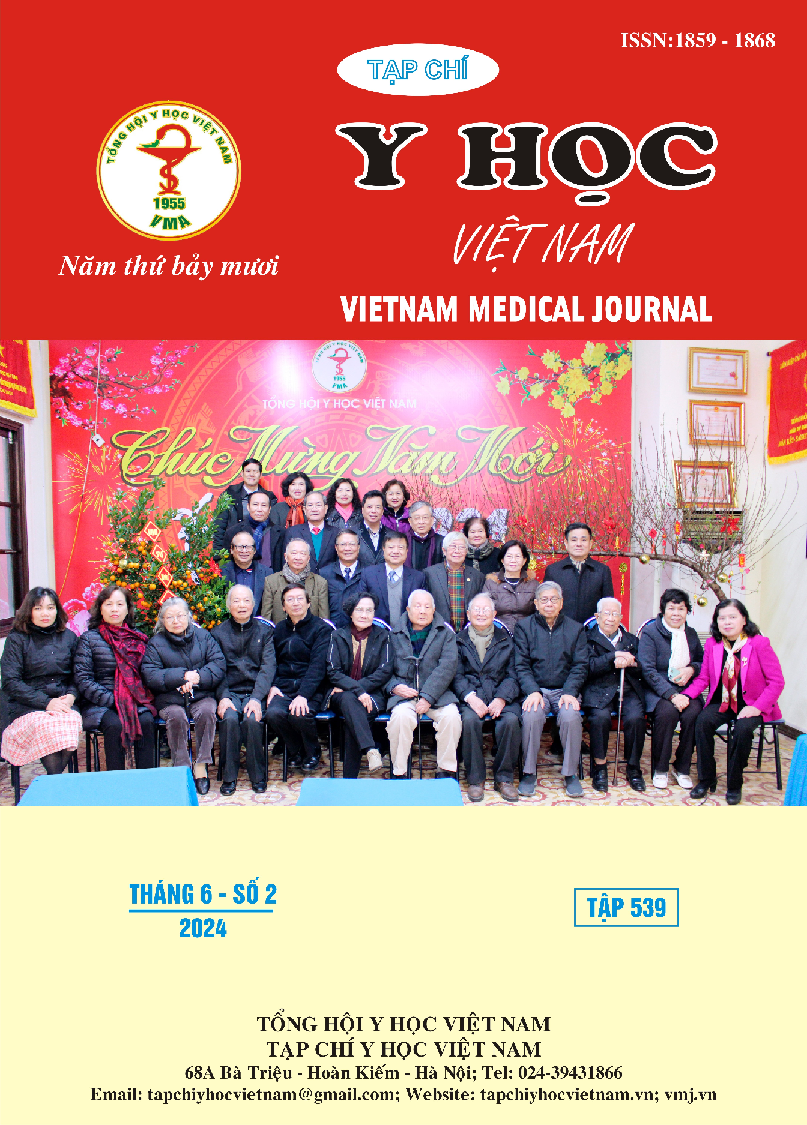THE PRIMARY ENTRY TEAR AND ACUTE TYPE A AORTIC DISSECTION: EXPERIENCES FROM A CENTER
Main Article Content
Abstract
Background: The location of entry tear not only affects prognosis but also the treatment strategy of aortic dissection. However, the relationship between the entry tear and surgical outcomes for acute type A aortic dissection remains unclear. Methods and results: We retrospectively reviewed all patients with acute type A aortic dissection who underwent surgery on at Viet Duc University Hospital in the period of 2021-2022. Of 89 patients, the entry tear at the ascending aorta had the highest rate, accounting for 43.8% and the proportions of the other two groups were quite equal. The group without the entry tear at the ascending aorta or aortic arch presented false lumen thrombosis most frequently. The position of entry tear influenced the extent of surgery, in which the majority of patients with entry tear at the aortic arch had the hemiarch or total arch replacement. Postoperatively, the early mortality rate and early reoperation rate were 11.2% and 5.6%, respectively. The most common cause of early death was multiorgan failure and that of reoperation was bleeding. After surgery, the early mortality rate tended to be higher in the group with lesions at the aortic arch (p=0.08), while those with entry tear at the ascending aorta showed more bleeding complications (p=0.07). Conclusion: Acute type A aortic dissection is a lethal condition with a high mortality rate. The location of entry tear plays an important role in planning surgical treatment and predicting the initial outcomes of surgery as well as the long-term progression of this disease after surgery.
Article Details
Keywords
Aortic dissection, entry tear, surgery.
References
2. Artur Evangelista, Armando Salas, Aida Ribera, Ignacio Ferreira-González, Hug Cuellar, Victor Pineda, Teresa González-Alujas, Bart Bijnens, Gaietà Permanyer-Miralda, David Garcia-Dorado. Long-term outcome of aortic dissection with patent false lumen: predictive role of entry tear size and location. Circulation. 2012 Jun 26;125(25):3133-41. doi: 10.1161 /CIRCULATIONAHA. 111. 090266. Epub 2012 May 21.
3. Czerny M, Schmidli J, Adler S, van den Berg J, Bertoglio L, Carrel T, Chiesa R, Clough RE, Eberle B, Etz C, Grabenwöger M, Haulon S, Jakob H, Kari FA, Mestres CA, Pacini D, Resch T, Rylski B, Schönhoff F, Shrestha M, von Tengg-Kobligk H, Tsagakis K, Wyss TR. Current options and recommendations for the treatment of thoracic aortic pathologies involving the aortic arch—an expert consensus document of the European Association for Cardio-Thoracic Surgery (EACTS) and the European Society of Vascular Surgery (ESVS). Eur J Cardiothorac Surg 2019;55;133–162. Google Scholar Crossref PubMed WorldCat
4. Martin Czerny, Bartosz Rylski. Acute type A aortic dissection reconsidered: it's all about the location of the primary entry tear and the presence or absence of malperfusion. Eur Heart J. 2021 Dec 28; 43(1): 53-55. doi: 10.1093/ eurheartj/ehab664.
5. Yosuke Inoue, Kenji Minatoya, Tatsuya Oda, Tatsuya Itonaga, Yoshimasa Seike, Hiroshi Tanaka, Hiroaki Sasaki, Junjiro Kobayashi, et al. Surgical outcomes for acute type A aortic dissection with aggressive primary entry resection. Eur J Cardiothorac Surg. 2016 Sep;50(3): 567-73. doi: 10. 1093/ejcts/ezw111. Epub 2016 Apr 3.
6. Wei-Guo Ma, Wei Zhang, Long-Fei Wang, Jun Zheng, Bulat A Ziganshin, Paris Charilaou, Xu-Dong Pan, Yong-Min Liu, Jun-Ming Zhu, Qian Chang, John A Rizzo, John A Elefteriades, Li-Zhong Sun. Type A aortic dissection with arch entry tear: Surgical experience in 104 patients over a 12-year period. J Thorac Cardiovasc Surg. 2016 Jun;151(6):1581-92. doi: 10.1016/j.jtcvs.2015.11.056. Epub 2015 Dec 13.
7. Yue Shi, Minjia Zhu, Yu Chang, Huanyu Qiao, Yongmin Liu. The risk of stanford type-A aortic dissection with different tear size and location: a numerical study. Biomed Eng Online. 2016 Dec 28;15(Suppl 2):128. doi: 10.1186/s12938-016-0258-y.
8. Tse KM, Lee HP, Pei H. Investigation of hemodynamics in the development of dissecting aneurysm within patient-specific dissecting aneurismal aortas using computational fluid dynamics (CFD) simulations. J Biomech. 2011; 44: 827–836. doi: 10.1016/ j.jbiomech.2010. 12.014.


